Ken Forkish’s “Flour Water Salt Yeast” is a must-have guide for bakers, offering deep insights into the fundamentals of bread making. This book emphasizes the importance of understanding flour, water, salt, and yeast, providing both basic and advanced techniques for crafting artisan bread. It’s a comprehensive resource for home bakers and professionals alike, ensuring mastery of the craft through detailed explanations and practical recipes.
Overview of the Book by Ken Forkish
Ken Forkish’s Flour Water Salt Yeast is a foundational guide for bakers, offering a detailed exploration of bread and pizza making. The book provides a comprehensive understanding of the four essential ingredients and their roles in creating artisanal bread. Forkish shares practical techniques, from basic straight dough to complex levain, ensuring readers master both classic and advanced methods. With clear, accessible language, the book serves as an educational resource, blending recipes with instructional insights. Its popularity endures, making it a go-to for home bakers and professionals seeking to refine their craft.
Importance of the Four Ingredients
The four ingredients—flour, water, salt, and yeast—are the backbone of bread making. Flour provides structure and nutrition, water hydrates and binds, salt enhances flavor and controls yeast, while yeast ferments sugars for rise. Balancing these elements is crucial for optimal dough development and bread quality. Each ingredient plays a distinct role, and their proportions significantly affect the final product. Understanding their interplay is key to mastering artisan bread, as emphasized in Flour Water Salt Yeast, making it a cornerstone for both novice and experienced bakers.
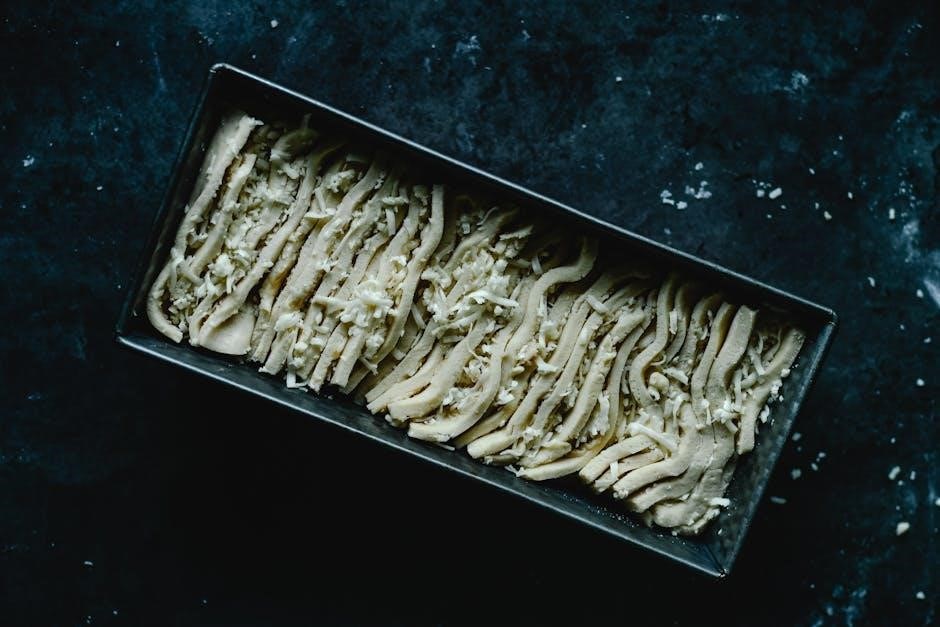
The Role of Flour in Bread Making
Flour is the foundation of bread, providing structure, texture, and nutrients. Its protein content determines gluten strength, affecting dough elasticity and rise. Proper flour selection is essential for achieving desired bread quality and hydration balance, as discussed in Flour Water Salt Yeast.
Types of Flour and Their Protein Content
Different flours vary in protein content, which affects gluten development. Bread flour typically has 12-14% protein for strong gluten, ideal for chewy breads. All-purpose flour, with 10-12% protein, balances strength and tenderness. Cake flour, at 8-10%, is low in protein, suitable for delicate baked goods. Whole wheat flour, often 14-16% protein, adds nutty flavor and denser texture. Understanding protein levels helps in selecting the right flour for desired dough elasticity and crumb structure, as detailed in Flour Water Salt Yeast.
How Flour Affects Dough Hydration
The type and protein content of flour significantly influence dough hydration. Higher-protein flours absorb more water, requiring increased hydration for optimal elasticity, while lower-protein flours need less. For example, bread flour with 12-14% protein may require 70-75% hydration, whereas all-purpose flour with 10-12% protein might need 65-70%. Proper hydration ensures the dough develops correctly, avoiding a too-dry or overly sticky texture. Balancing flour and water is crucial for achieving the desired crumb and chew in bread, as emphasized in Flour Water Salt Yeast.
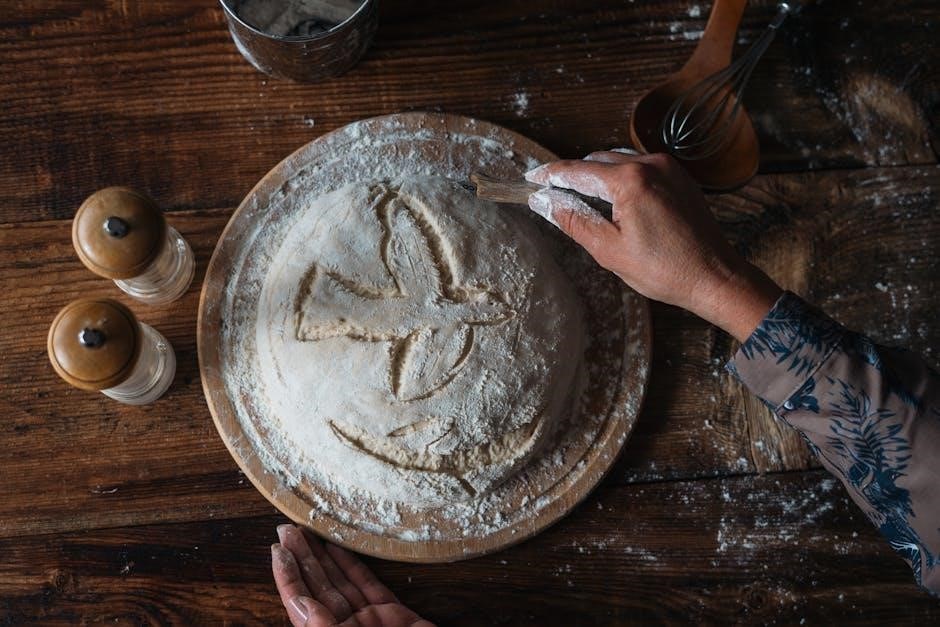
Understanding Water in Dough Preparation
Water plays a crucial role in dough preparation, affecting hydration levels and texture. Its purity and temperature significantly influence yeast activity and dough development.
The Concept of Hydration and Its Calculation
Hydration in bread making refers to the ratio of water to flour by weight. It is calculated by dividing the water weight by the flour weight, expressed as a percentage. For example, 750g of water to 1000g of flour results in 75% hydration. This ratio significantly impacts dough texture and bread structure. Higher hydration doughs are more challenging to handle but produce airier crumb, while lower hydration doughs yield denser bread. Accurate measurement is crucial, as small variations can affect dough consistency and final results.
Water Quality and Temperature for Optimal Yeast Activity
Water quality and temperature play a crucial role in yeast activity. Chlorinated water can inhibit yeast growth, so using filtered or bottled water is often recommended. Ideal water temperature for yeast activation is between 75°F and 80°F (24°C to 27°C), as extreme temperatures can kill or slow down yeast. Cold water prolongs fermentation, while overly hot water risks damaging the yeast. Ensuring the right temperature and using high-quality water helps create an optimal environment for fermentation, leading to better dough rise and bread texture;
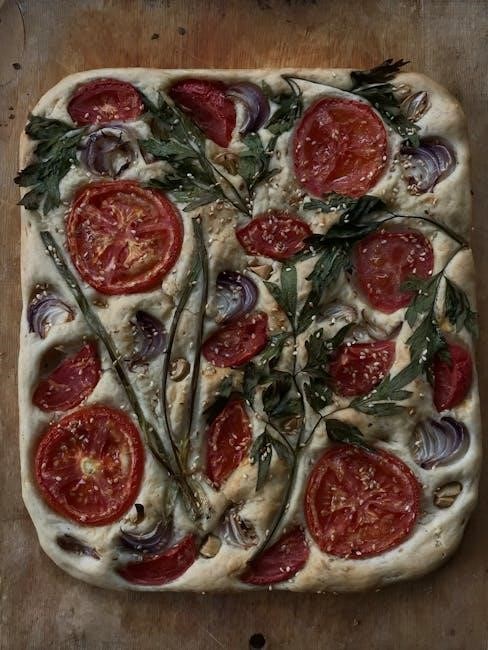
Salt’s Function Beyond Seasoning
Salt enhances flavor, controls yeast growth, and strengthens dough structure, ensuring proper fermentation and texture in bread making, while also preserving freshness and improving crust quality.
How Salt Enhances Flavor and Controls Yeast Growth
Salt is a critical ingredient in bread making, as it enhances the natural sweetness of flour and balances the savory flavors of other components. Beyond seasoning, salt plays a vital role in controlling yeast activity by slowing down fermentation, preventing the dough from over-proofing. This balance ensures a well-structured crumb and crust. Additionally, salt strengthens gluten networks, contributing to dough elasticity and texture. By understanding the precise amount of salt needed, bakers can achieve optimal flavor and maintain microbial equilibrium, resulting in a more complex and satisfying loaf of bread.
Recommended Amounts of Salt in Bread Recipes
The recommended salt amount in bread recipes typically ranges between 1.8% to 2.2% of the total flour weight. For example, with 1,000 grams of flour, 18 to 22 grams of salt is suggested. This ratio enhances flavor without overpowering the bread. Salt levels can be adjusted based on personal preference or specific bread types, such as lower for delicate breads or higher for hearty varieties. Proper measurement ensures the dough’s microbial balance and structural integrity, contributing to a well-rounded and satisfying bake.
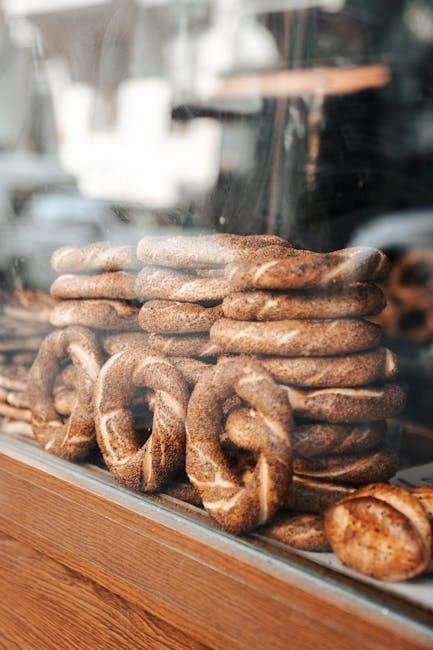
The Science of Yeast in Fermentation
Yeast is a microorganism that converts sugars into carbon dioxide and alcohol, driving fermentation. Its activity depends on temperature, hydration, and nutrients, optimizing dough rise and flavor development.
Understanding Yeast Types and Their Roles
Yeast types vary, with instant, active dry, and sourdough starters being common. Instant yeast, like SAF Red, activates quickly, ideal for rapid fermentation. Active dry yeast requires rehydration before use, ensuring viability. Sourdough starters rely on wild yeast and bacteria for slower, more complex fermentation. Each type affects dough rise, flavor, and production time. Factors like temperature, hydration, and sugar availability influence yeast activity. Accurate measurement is crucial for balancing yeast levels, especially in recipes with minimal yeast for longer proofing. Understanding yeast roles enhances control over fermentation and final bread quality.
Yeast Activation and Proofing Techniques
Yeast activation involves rehydrating dry yeast in warm water to ensure viability, while instant yeast can be added directly. Proofing confirms yeast activity by observing bubbles. Temperature and sugar availability significantly impact fermentation speed. Over-proofing can lead to dough collapse, while under-proofing results in dense bread. Ken Forkish emphasizes precise measurement and environmental control to optimize yeast performance. Proper techniques ensure consistent rises and flavorful bread, whether using commercial yeast or natural sourdough starters for artisanal results.
Tools and Equipment for Bread Making
Essential tools include a mixing bowl, measuring scales, dough scraper, and proofing basket. Accurate scales ensure precise measurements, while video tutorials guide equipment selection and usage effectively.
Essential Tools Every Baker Should Have
A digital scale is crucial for precise measurements, ensuring accurate hydration and ingredient ratios. A sturdy mixing bowl, dough scraper, and proofing basket are foundational. Video tutorials often demonstrate how to effectively use these tools, while resources like Flour Water Salt Yeast emphasize their importance. Additionally, a bench knife and linen or canvas for proofing are highly recommended. These tools, along with small scales for yeast and salt, create an efficient workspace, allowing bakers to focus on crafting high-quality bread.
The Importance of Accurate Measurement Scales
Accurate measurement scales are vital for precise ingredient ratios, especially in bread making. Bakers’ math relies on flour as the base (100%), with water, salt, and yeast calculated proportionally. Small errors in measurement can significantly affect hydration levels and dough balance. For instance, a 75% hydration dough with 500g flour requires 375g water. Without precise scales, achieving consistent results becomes challenging. This emphasis on accuracy ensures optimal fermentation and texture, making scales an indispensable tool for both novice and experienced bakers.
Dough Preparation Techniques
Dough preparation involves precise mixing and autolyse processes. High-hydration doughs require gentle handling to avoid overworking, ensuring optimal gluten development. Accurate scales and techniques are essential for consistency.
Mixing and Autolyse Process
The mixing and autolyse process are critical in bread making. Autolyse involves mixing flour and water to initiate hydration and gluten development, resting for 20-30 minutes. This step enhances dough structure and simplifies mixing. After autolyse, yeast and salt are added, followed by gentle mixing to avoid overworking. Accurate measurements and minimal agitation ensure optimal hydration and fermentation. This method promotes even yeast activity and contributes to a balanced crumb and crust development, as detailed in Ken Forkish’s techniques.
Handling High-Hydration Doughs
High-hydration doughs, as explored in “Flour Water Salt Yeast,” require careful handling to achieve the right balance of moisture and structure. Ken Forkish emphasizes the importance of gentle mixing and minimal agitation to prevent overworking the gluten. Techniques like stretching and folding, rather than traditional kneading, help build dough strength without excess tension. Using pre-ferments can enhance extensibility, while maintaining the right temperature and hydration levels ensures a smooth, even fermentation. Proper handling leads to a tender crumb and a chewy, well-developed crust, making high-hydration breads a rewarding challenge for bakers.

Fermentation and Proofing
Fermentation is a critical process where yeast converts sugars into carbon dioxide, developing dough structure and flavor. Proofing requires a warm, draft-free environment to optimize yeast activity and dough rise.
Stages of Fermentation Explained
Fermentation occurs in stages, beginning with bulk fermentation, where yeast ferments sugars, producing carbon dioxide and developing dough structure. After shaping, the dough enters proofing, a shorter, final rise where flavors mature. Temperature and time are critical; optimal yeast activity occurs between 75°F and 80°F. Over-proofing can lead to a dense crumb, while under-proofing results in inadequate rise. Monitoring these stages ensures proper dough development and a balanced, airy texture in the finished bread.
Creating the Ideal Environment for Proofing
Creating an ideal proofing environment involves maintaining consistent temperature and humidity. A proofing box or a covered area with controlled conditions is essential. Typically, a temperature range of 75°F to 80°F and 70-80% humidity is optimal for yeast activity. Using a damp towel or a pan of water nearby helps maintain moisture. Avoid drafts, as they can disrupt even proofing. Covering the dough prevents drying and ensures even fermentation. These conditions promote balanced yeast growth, leading to a well-developed crumb and flavorful bread.
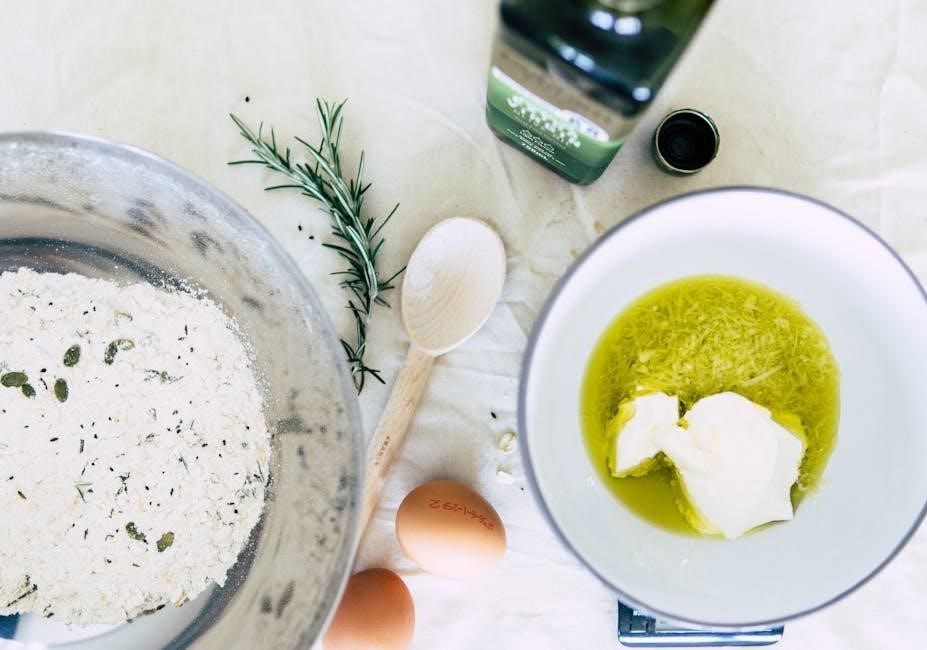
Advanced Techniques for Artisan Bread
Explore expert methods like pre-ferments, levain, and biga to enhance flavor and texture. Master scoring techniques for a professional finish, elevating your bread to artisanal excellence.
Using Pre-Ferments Like Levain and Biga
Pre-ferments like levain and biga are essential for enhancing bread flavor and texture. Levain, a natural starter, ferments longer, adding complexity, while biga is a prefermented dough. Both methods allow for better dough hydration and a more open crumb. To use levain, mix flour and water, letting it ferment before incorporating into the dough. Biga is prepared similarly but often with yeast for quicker results. These techniques boost yeast activity and create a more aromatic loaf. They’re versatile and can be adapted to various bread recipes for superior outcomes.
Mastering the Art of Scoring Bread
Scoring bread is a critical step that enhances both appearance and texture. Using a lame or razor blade, precise cuts guide the dough’s expansion during baking. Proper scoring ensures even rise and prevents uneven cracking. Practice is key to mastering this technique, as deep, confident cuts yield the best results. Ken Forkish emphasizes sharp tools and steady hands for clean, effective scores. This step transforms dough into a visually stunning, professional-looking loaf, making it a fundamental skill for any serious baker to perfect.
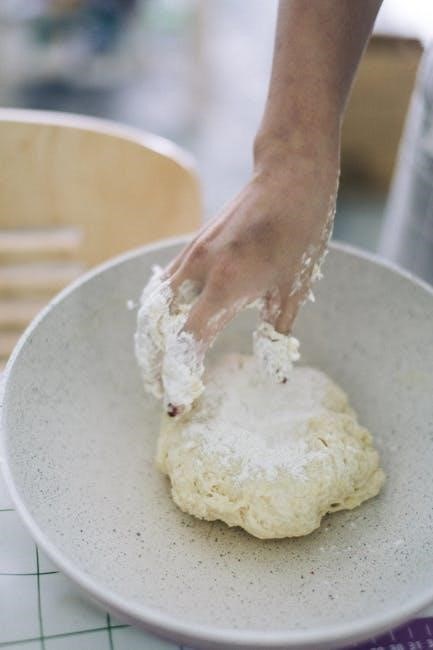
Troubleshooting Common Baking Issues
Common issues like over-proofing or under-proofed dough can be fixed by adjusting proofing time or yeast amounts. Hydration problems can be resolved by tweaking flour or water ratios;
Fixing Over-Proofed or Under-Proofed Dough
Over-proofed dough can be salvaged by gently folding it to redistribute gases, while under-proofed dough may need more time to rise. Adjusting yeast quantities and ambient temperature can prevent these issues. Monitoring proofing stages ensures better control, helping bakers achieve the perfect balance for their bread.
Addressing Issues with Dough Hydration
Dough hydration issues can be resolved by adjusting flour or water amounts. If dough is too wet, add small increments of flour; if too dry, gradually add water. Proper hydration balance ensures dough strength and extensibility, crucial for achieving the desired texture in bread. Monitoring hydration levels during mixing and proofing helps prevent over- or under-hydration, ensuring a consistent and high-quality bake. Regular practice refine hydration skills, leading to better dough handling and baking outcomes.
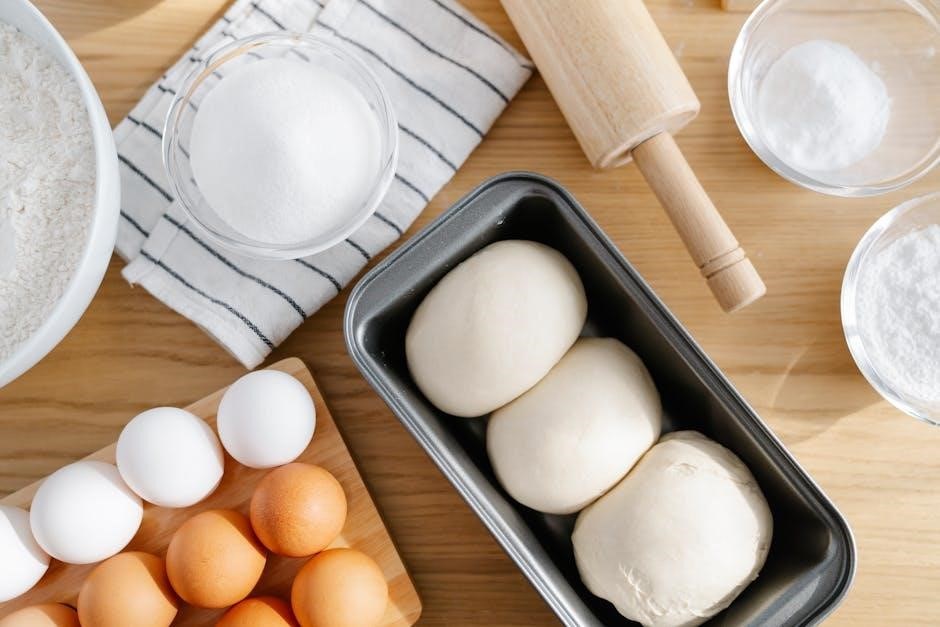
The Impact of “Flour Water Salt Yeast” on Baking
Ken Forkish’s “Flour Water Salt Yeast” revolutionized home baking by simplifying complex techniques and emphasizing the importance of quality ingredients. The book’s clear instructions and detailed recipes empowered bakers worldwide, making artisan bread accessible to everyone. Its popularity and educational value have solidified its place as a cornerstone of modern baking education.
How the Book Revolutionized Home Baking
Ken Forkish’s “Flour Water Salt Yeast” transformed home baking by breaking down complex techniques into accessible, step-by-step instructions. It introduced bakers to the concept of hydration, autolyse, and precise measurements, empowering them to create professional-quality bread. The book’s focus on understanding the four core ingredients and their roles in bread making demystified artisan baking. By combining science with practicality, Forkish inspired a new generation of bakers to experiment and master traditional methods, fostering a community of enthusiasts who value quality and craftsmanship in their baking journey.
Reader Reviews and Testimonials
Readers praise “Flour Water Salt Yeast” for its clarity and depth, calling it a game-changer for home bakers. Many highlight how the book demystifies artisan bread making, making it accessible to all skill levels. Testimonials often mention the book’s meticulous approach to hydration, autolyse, and yeast activation, which has improved their baking results. Amazon reviews frequently note its detailed recipes and educational value, with many calling it a must-have for bread enthusiasts. The book’s popularity is evident, with it ranking high in bread baking categories and being recommended by online baking communities like TheFreshLoaf.com.
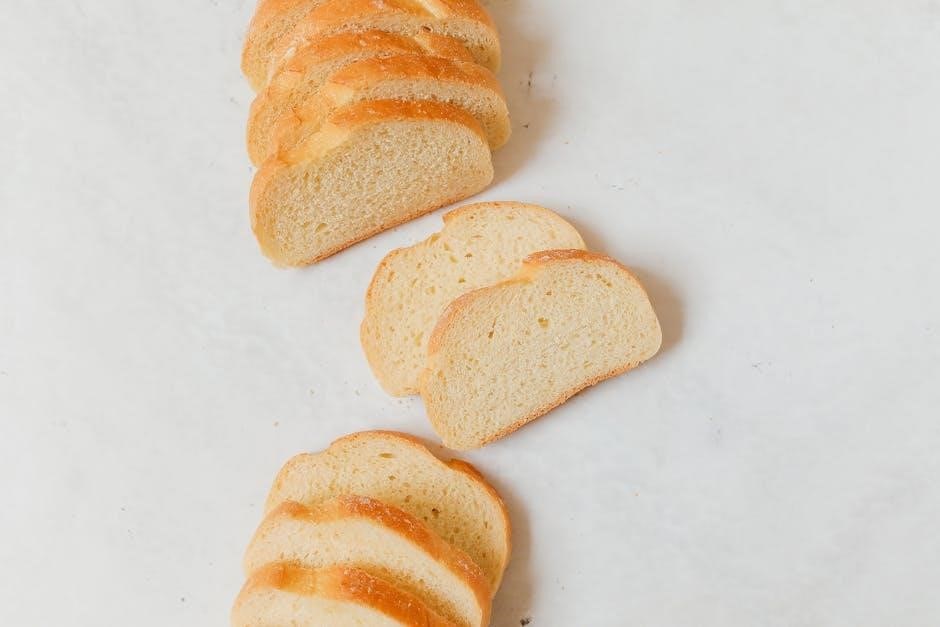
Additional Resources and Guides
Find “Flour Water Salt Yeast” on Amazon, Barnes & Noble, IndieBound, and Google iBooks. Supplementary online resources, video tutorials, and baking communities like TheFreshLoaf.com enhance learning and mastery.
Online Tutorials and Video Demonstrations
Online platforms like TheFreshLoaf.com and YouTube offer extensive tutorials and video guides for bread baking, complementing the techniques in “Flour Water Salt Yeast.” These resources provide step-by-step demonstrations of processes such as autolyse, mixing, and handling high-hydration doughs. Videos often cover pre-ferment creation, scoring techniques, and proofing setups, allowing bakers to visualize complex methods. Additionally, digital tools like dough calculators and water temperature guides are available to enhance accuracy and consistency in bread making. These resources empower bakers to refine their skills and explore advanced techniques with confidence.
Recommended Tools and Ingredients from the Book
Ken Forkish recommends essential tools like accurate measurement scales, dough scrapers, and bench scrapers for precise dough handling. Ingredients such as King Arthur All-Purpose Unbleached Flour, fine sea salt, and SAF Red Instant Yeast are highlighted for their quality and reliability. These tools and ingredients ensure consistency and professional results, making them indispensable for both novice and experienced bakers. Forkish also provides guidance on sourcing these items, often available at local grocery stores or through online retailers, to help bakers achieve the best outcomes in their recipes.
“Flour Water Salt Yeast” masterfully guides bakers in understanding bread fundamentals, empowering them to create exceptional bread through precise techniques and timeless recipes, inspiring endless culinary exploration.
Final Thoughts on Mastering the Fundamentals
Mastery of bread making begins with understanding flour, water, salt, and yeast. Each ingredient plays a vital role, and their balance is key to achieving exceptional results. Practice and patience are essential, as bread baking is both an art and a science. By grasping these fundamentals, bakers can experiment confidently, exploring new techniques and recipes. Ken Forkish’s insights in “Flour Water Salt Yeast” provide a solid foundation, inspiring bakers to elevate their craft and create bread that reflects their dedication and passion.
Encouragement to Experiment and Learn
Embrace experimentation as a vital part of the baking journey. Don’t fear mistakes—they’re opportunities to learn and refine techniques. Forkish’s guidance in “Flour Water Salt Yeast” empowers bakers to explore beyond recipes, fostering creativity and skill. By understanding the interplay of ingredients and processes, bakers can innovate confidently. Keep practicing, stay curious, and enjoy the rewarding process of creating bread that brings joy to you and others. Every loaf tells a story of growth and passion.




About the author